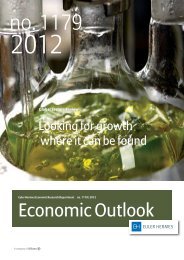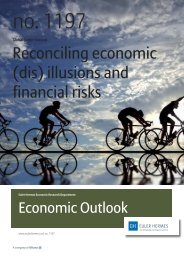Reindustrialization in USA - Euler Hermes
Reindustrialization in USA - Euler Hermes
Reindustrialization in USA - Euler Hermes
You also want an ePaper? Increase the reach of your titles
YUMPU automatically turns print PDFs into web optimized ePapers that Google loves.
Economic Outlook n° 1187 | Special Report | The <strong>Re<strong>in</strong>dustrialization</strong> of the United States<strong>Euler</strong> <strong>Hermes</strong>A f<strong>in</strong>al segment of note, communication equipmentproduction has been lagg<strong>in</strong>g far below its 2007 leveldespite a rebound <strong>in</strong> 2010.The 2012 output <strong>in</strong>crease is expected to slow dramatically(estimated at +3.5%) because the two ma<strong>in</strong>growth drivers appear to have paused <strong>in</strong> their ascent.2013 will follow this downward trend (+1.5%).u Mach<strong>in</strong>eryThis sector contributed strongly to U.S. manufactur<strong>in</strong>goutput expansion with double digit growth<strong>in</strong> 2010 and <strong>in</strong> 2011. It is also expected to rega<strong>in</strong> itspre-recession average annual production. All the subsectorshave posted significant production <strong>in</strong>creasesdur<strong>in</strong>g this period follow<strong>in</strong>g a rebound <strong>in</strong> <strong>in</strong>vestment<strong>in</strong> the aftermath of the crisis. Two sub-sectors havebeen significant growth drivers and showed higherlevels of production <strong>in</strong> 2012 than <strong>in</strong> 2007/2008:• M<strong>in</strong><strong>in</strong>g, oil field and gas field mach<strong>in</strong>ery (output:+2.6%<strong>in</strong> 2010 and +21.3% <strong>in</strong> 2011 and+14.9% (estimated) <strong>in</strong> 2012). This segment hasthrived <strong>in</strong> the wake of the surges <strong>in</strong> oil <strong>in</strong>dustryextraction capacity and that of the shale gas<strong>in</strong>dustry <strong>in</strong> the U.S., driven by the development ofnew technologies.• Eng<strong>in</strong>e, turb<strong>in</strong>e and power transmission equipment(output: +9.7% <strong>in</strong> 2010 and +22.6% <strong>in</strong> 2011and +18.5% (estimated) <strong>in</strong> 2012). The noticeabledevelopment of the renewable energy sector hasfostered growth <strong>in</strong> this segment.The construction and metalwork<strong>in</strong>g mach<strong>in</strong>ery sectorsalso have fared reasonably well <strong>in</strong> 2012. Theunderly<strong>in</strong>g conditions which stimulated mach<strong>in</strong>erysector growth over the recent years - <strong>in</strong>clud<strong>in</strong>g11. Industrial Production Index:the “sh<strong>in</strong><strong>in</strong>g” manufactur<strong>in</strong>g sectorsIndex basis 100 =‐2007among others, boom<strong>in</strong>g <strong>in</strong>vestments <strong>in</strong> fossil andrenewable energy, strong global economics favorableto U.S. exports - are likely to fade <strong>in</strong> 2013 withthe current fiscal/budget uncerta<strong>in</strong>ty weigh<strong>in</strong>g itsprospects down dramatically. The expectation is thatthe output growth of the mach<strong>in</strong>ery sector should berather limited (+3%).u Petroleum and coal product manufactur<strong>in</strong>gThis sector has reclaimed its pre-recession benchmarkdue to momentum posted by the “pav<strong>in</strong>g, roof<strong>in</strong>gand other petroleum and coal products” sector,which <strong>in</strong>creased its production by 8.6%, 15.1% and13.1% (estimated) <strong>in</strong> 2010, 2011 and 2012 respectively.This momentum was due <strong>in</strong> large part to thefederal stimulus package aimed at boost<strong>in</strong>g the U.S.economy and <strong>in</strong>cluded $36.2 billion for transportation(highway <strong>in</strong>frastructure, high-speed rail corridors)and $30.0 billion for <strong>in</strong>frastructure. In 2013, thepetroleum and coal product manufactur<strong>in</strong>g sectorwon’t be able to rely on such public support and islikely to suffer from this less favorable environment.u What about the car <strong>in</strong>dustry?Despite uneven global economic performance,<strong>in</strong>clud<strong>in</strong>g weakness <strong>in</strong> Europe, many global automakershave reported ris<strong>in</strong>g sales and profitability,driven by growth <strong>in</strong> emerg<strong>in</strong>g markets and Ch<strong>in</strong>a <strong>in</strong>particular. In the U.S., auto sales posted a second yearof growth due to easier credit, low <strong>in</strong>terest rates, andpent-up demand result<strong>in</strong>g from the recent recessionand an ag<strong>in</strong>g vehicle fleet. North American auto suppliersare benefit<strong>in</strong>g from ris<strong>in</strong>g automotive productionand leaner cost structures. Many are now moreprofitable than before the downturn. The outlook forboth the automotive manufacturers and suppliers ispositive, reflect<strong>in</strong>g expectations for ris<strong>in</strong>g demand <strong>in</strong>the U.S. In addition, emerg<strong>in</strong>g markets led by Ch<strong>in</strong>ashould drive global demand, despite slow<strong>in</strong>g regionaleconomic growth and debt issues affect<strong>in</strong>g Europeandemand. The U.S. automotive market is still strengthen<strong>in</strong>g:it grew an estimated 12% to 14.8 million vehicles<strong>in</strong> 2012 and we expect it to grow 5% more to 15.5million vehicles <strong>in</strong> 2013. That will still be 1.5 millionvehicles short of the pre-crisis benchmark.©Source: Federal Reserve Bank15












